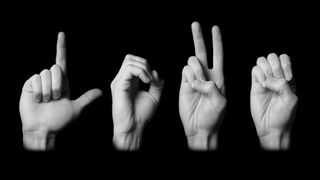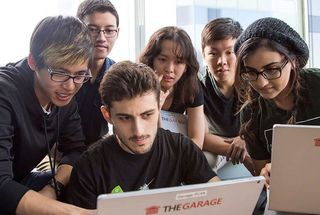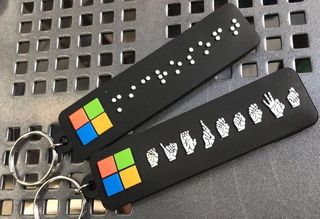How Microsoft helps deaf people 'hear'
There are 360 million people in the world who are deaf or hard of hearing. Microsoft's inclusion mission embraces them within its workforce and brings them some of the benefits of hearing via technology.

Some degree of hearing loss is virtually inevitable as we age. Sadly other factors, such as loud noises, disease, injury or congenital disabilities, rob millions of others of the vital sense. As with many disabilities, individuals who are deaf or hard of hearing face discrimination in various areas of life, including employment opportunities.
Additionally, a person's inability to hear could have adverse effects on how they interact socially. Thus, they may be uncomfortable or lack confidence in certain social settings. How others embrace or fail to embrace them could also affect them. An inability to hear could be a life-threatening condition, as well, if an individual is unable to perceive environmental cues to alert them to danger.
Microsoft's inclusion mission seeks to move beyond discriminatory practices by bringing people who are deaf or hard of hearing into its workforce. The company is also producing technology that will enable these individuals to experience some of the benefits of hearing.
- How fathering a son with disabilities helped Microsoft's CEO transform the company
- Microsoft's Autism Hiring Program aims to attract diverse talent
- How Microsoft used tech to help people with ALS regain mobility
- How Microsoft's inclusion mission is helping the blind to 'see'
Hearing the mission
Swetha Machanavajhala is a software engineer at Microsoft who is also deaf. She embraces the opportunities available to her at the company and encourages others, regardless of abilities or disabilities, to pursue employment with Microsoft. As a person with hearing loss, she is particularly sensitive to the needs of others facing similar challenges.
In 2015, Machanavajhala was inspired to participate in Microsoft's annual Hackathon event. The event allows Microsoft employees from all over to bring unique ideas to the table and work within teams to bring these ideas to fruition. Machanavalhala led a team of 16 people who helped bring an idea to help people who are deaf or hard of hearing become a reality.
The team's prototype of Machanavalhala's idea won second place in the "Technology for Good" category in the worldwide Hackathon. This accomplishment is just one example that proves that having a disability does not hinder a person's creativity, leadership abilities or vision. Machanavajhala was inspired by her team's accomplishment. And like the Hackathon project that brought mobility to Steve Gleason who has ALS, she invested time and resources to move her Hackathon project from prototype to product.
Microsoft's Hearing AI app

The team that worked on what would ultimately become the Hearing AI app had this to say about its motivation to work on the project:
Get the Windows Central Newsletter
All the latest news, reviews, and guides for Windows and Xbox diehards.
We were motivated to build this application when we heard a story about a woman who is deaf who almost lost her life as a result of an inaccessible carbon monoxide alarm that rang for two weeks without notice. [We] realized that there are many instances where sounds contain cultural or contextual importance but are not accessible to everyone.
People often take for granted the ambiance of sounds and audible nuances that are a persistent part of our perceptions. We're also acquainted with the sudden interjection of sounds into that ambiance, which may alert us to danger. As the team noted, people with hearing loss don't share that experience. Therefore, they set out to approximate that experience with technology.
The Hearing AI app became a reality in 2016 and has three primary functions:
- Visualizations allow users to see the activity, volume, and ambiance of the sounds around them. They even let users know if the sound is loud enough to damage one's ears.
- Notifications alert users to sudden changes in important sounds.
- Speech-To-Text provides real-time transcription of speech. It also gives an indicator of the volume at which someone is speaking. (This particular nuance is essential for social interactions.)
The Hearing AI app is currently available as a limited release for iOS.
Keeping an open ear is key

Everyone has something to contribute regardless of their level of ability. As we see with Machanavajhala, a person with a hearing impairment can make profound contributions that can potentially benefit millions. This accomplishment echoes that of Saquib Shaikh, a blind Microsoft programmer who created the Seeing AI app, which is also available in the App Store.
We would all love to live in a world where various maladies did not rob some of us of the senses or abilities others have. But empathy coupled with ingenuity brings us together to help those affected by circumstance to overcome those challenges through technology and basic human kindness.
I think it is fitting to end this piece with an excerpt from the team who brought the world Hearing AI:
If we could leave one message, it's to be more aware of how the small things that you take for granted in your daily lives are not always accessible for everyone, and that we should all work together to promote a more inclusive society.
Amen to that.
Jason L Ward is a columnist at Windows Central. He provides unique big picture analysis of the complex world of Microsoft. Jason takes the small clues and gives you an insightful big picture perspective through storytelling that you won't find *anywhere* else. Seriously, this dude thinks outside the box. Follow him on Twitter at @JLTechWord. He's doing the "write" thing!

